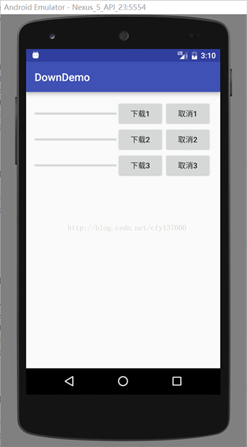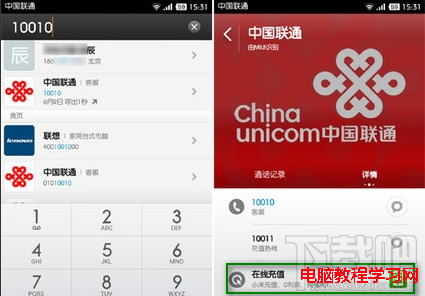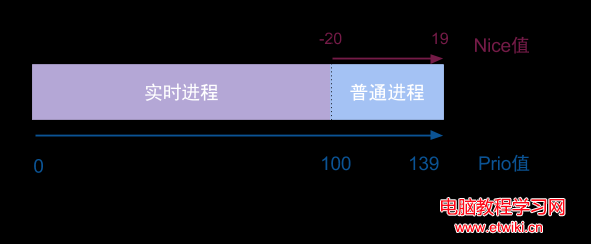編輯:關於Android編程
OKHttp3是如今非常流行的Android網絡請求框架,那麼如何利用Android實現斷點續傳呢,今天寫了個Demo嘗試了一下,感覺還是有點意思
准備階段
我們會用到OKHttp3來做網絡請求,使用RxJava來實現線程的切換,並且開啟Java8來啟用Lambda表達式,畢竟RxJava實現線程切換非常方便,而且數據流的形式也非常舒服,同時Lambda和RxJava配合食用味道更佳
打開我們的app Module下的build.gradle,代碼如下
apply plugin: 'com.android.application'
android {
compileSdkVersion 24
buildToolsVersion "24.0.3"
defaultConfig {
applicationId "com.lanou3g.downdemo"
minSdkVersion 15
targetSdkVersion 24
versionCode 1
versionName "1.0"
testInstrumentationRunner "android.support.test.runner.AndroidJUnitRunner"
//為了開啟Java8
jackOptions{
enabled true;
}
}
buildTypes {
release {
minifyEnabled false
proguardFiles getDefaultProguardFile('proguard-android.txt'), 'proguard-rules.pro'
}
}
//開啟Java1.8 能夠使用lambda表達式
compileOptions{
sourceCompatibility JavaVersion.VERSION_1_8
targetCompatibility JavaVersion.VERSION_1_8
}
}
dependencies {
compile fileTree(dir: 'libs', include: ['*.jar'])
androidTestCompile('com.android.support.test.espresso:espresso-core:2.2.2', {
exclude group: 'com.android.support', module: 'support-annotations'
})
compile 'com.android.support:appcompat-v7:24.1.1'
testCompile 'junit:junit:4.12'
//OKHttp
compile 'com.squareup.okhttp3:okhttp:3.6.0'
//RxJava和RxAndroid 用來做線程切換的
compile 'io.reactivex.rxjava2:rxandroid:2.0.1'
compile 'io.reactivex.rxjava2:rxjava:2.0.1'
}
OKHttp和RxJava,RxAndroid使用的都是最新的版本,並且配置開啟了Java8
布局文件
接著開始書寫布局文件
<?xml version="1.0" encoding="utf-8"?>
<LinearLayout xmlns:android="http://schemas.android.com/apk/res/android"
xmlns:tools="http://schemas.android.com/tools"
android:id="@+id/activity_main"
android:layout_width="match_parent"
android:layout_height="match_parent"
android:paddingBottom="@dimen/activity_vertical_margin"
android:paddingLeft="@dimen/activity_horizontal_margin"
android:paddingRight="@dimen/activity_horizontal_margin"
android:paddingTop="@dimen/activity_vertical_margin"
android:orientation="vertical"
tools:context="com.lanou3g.downdemo.MainActivity">
<LinearLayout
android:layout_width="match_parent"
android:layout_height="wrap_content"
android:orientation="horizontal">
<ProgressBar
android:id="@+id/main_progress1"
android:layout_width="0dp"
android:layout_weight="1"
android:layout_height="match_parent"
/>
<Button
android:id="@+id/main_btn_down1"
android:layout_width="wrap_content"
android:layout_height="wrap_content"
android:text="下載1"/>
<Button
android:id="@+id/main_btn_cancel1"
android:layout_width="wrap_content"
android:layout_height="wrap_content"
android:text="取消1"/>
</LinearLayout>
<LinearLayout
android:layout_width="match_parent"
android:layout_height="wrap_content"
android:orientation="horizontal">
<ProgressBar
android:id="@+id/main_progress2"
android:layout_width="0dp"
android:layout_weight="1"
android:layout_height="match_parent"
/>
<Button
android:id="@+id/main_btn_down2"
android:layout_width="wrap_content"
android:layout_height="wrap_content"
android:text="下載2"/>
<Button
android:id="@+id/main_btn_cancel2"
android:layout_width="wrap_content"
android:layout_height="wrap_content"
android:text="取消2"/>
</LinearLayout>
<LinearLayout
android:layout_width="match_parent"
android:layout_height="wrap_content"
android:orientation="horizontal">
<ProgressBar
android:id="@+id/main_progress3"
android:layout_width="0dp"
android:layout_weight="1"
android:layout_height="match_parent"
/>
<Button
android:id="@+id/main_btn_down3"
android:layout_width="wrap_content"
android:layout_height="wrap_content"
android:text="下載3"/>
<Button
android:id="@+id/main_btn_cancel3"
android:layout_width="wrap_content"
android:layout_height="wrap_content"
android:text="取消3"/>
</LinearLayout>
</LinearLayout>
大概是這個樣子的

3個ProgressBar就是為了顯示進度的,每個ProgressBar對應2個Button,一個是開始下載,一個是暫停(取消)下載,這裡需要說明的是,對下載來說暫停和取消沒有什麼區別,除非當取消的時候,會順帶把臨時文件都刪除了,在本例裡是不區分他倆的.
Application
我們這裡需要用到一些文件路徑,有一個全局Context會比較方便, 而Application也是Context的子類,使用它的是最方便的,所以我們寫一個類來繼承Application
package com.lanou3g.downdemo;
import android.app.Application;
import android.content.Context;
/**
* Created by 陳豐堯 on 2017/2/2.
*/
public class MyApp extends Application {
public static Context sContext;//全局的Context對象
@Override
public void onCreate() {
super.onCreate();
sContext = this;
}
}
可以看到,我們就是要獲得一個全局的Context對象的
我們在AndroidManifest中注冊一下我們的Application,同時再把我們所需要的權限給上
<?xml version="1.0" encoding="utf-8"?>
<manifest xmlns:android="http://schemas.android.com/apk/res/android"
package="com.lanou3g.downdemo">
<!--網絡權限-->
<uses-permission android:name="android.permission.INTERNET"/>
<application
android:allowBackup="true"
android:icon="@mipmap/ic_launcher"
android:label="@string/app_name"
android:supportsRtl="true"
android:name=".MyApp"
android:theme="@style/AppTheme">
<activity android:name=".MainActivity">
<intent-filter>
<action android:name="android.intent.action.MAIN" />
<category android:name="android.intent.category.LAUNCHER" />
</intent-filter>
</activity>
</application>
</manifest>
我們只需要一個網絡權限,在application標簽下,添加name屬性,來指向我們的Application
DownloadManager
接下來是核心代碼了,就是我們的DownloadManager,先上代碼
package com.lanou3g.downdemo;
import java.io.File;
import java.io.FileOutputStream;
import java.io.IOException;
import java.io.InputStream;
import java.util.HashMap;
import java.util.concurrent.atomic.AtomicReference;
import io.reactivex.Observable;
import io.reactivex.ObservableEmitter;
import io.reactivex.ObservableOnSubscribe;
import io.reactivex.android.schedulers.AndroidSchedulers;
import io.reactivex.schedulers.Schedulers;
import okhttp3.Call;
import okhttp3.OkHttpClient;
import okhttp3.Request;
import okhttp3.Response;
/**
* Created by 陳豐堯 on 2017/2/2.
*/
public class DownloadManager {
private static final AtomicReference<DownloadManager> INSTANCE = new AtomicReference<>();
private HashMap<String, Call> downCalls;//用來存放各個下載的請求
private OkHttpClient mClient;//OKHttpClient;
//獲得一個單例類
public static DownloadManager getInstance() {
for (; ; ) {
DownloadManager current = INSTANCE.get();
if (current != null) {
return current;
}
current = new DownloadManager();
if (INSTANCE.compareAndSet(null, current)) {
return current;
}
}
}
private DownloadManager() {
downCalls = new HashMap<>();
mClient = new OkHttpClient.Builder().build();
}
/**
* 開始下載
*
* @param url 下載請求的網址
* @param downLoadObserver 用來回調的接口
*/
public void download(String url, DownLoadObserver downLoadObserver) {
Observable.just(url)
.filter(s -> !downCalls.containsKey(s))//call的map已經有了,就證明正在下載,則這次不下載
.flatMap(s -> Observable.just(createDownInfo(s)))
.map(this::getRealFileName)//檢測本地文件夾,生成新的文件名
.flatMap(downloadInfo -> Observable.create(new DownloadSubscribe(downloadInfo)))//下載
.observeOn(AndroidSchedulers.mainThread())//在主線程回調
.subscribeOn(Schedulers.io())//在子線程執行
.subscribe(downLoadObserver);//添加觀察者
}
public void cancel(String url) {
Call call = downCalls.get(url);
if (call != null) {
call.cancel();//取消
}
downCalls.remove(url);
}
/**
* 創建DownInfo
*
* @param url 請求網址
* @return DownInfo
*/
private DownloadInfo createDownInfo(String url) {
DownloadInfo downloadInfo = new DownloadInfo(url);
long contentLength = getContentLength(url);//獲得文件大小
downloadInfo.setTotal(contentLength);
String fileName = url.substring(url.lastIndexOf("/"));
downloadInfo.setFileName(fileName);
return downloadInfo;
}
private DownloadInfo getRealFileName(DownloadInfo downloadInfo) {
String fileName = downloadInfo.getFileName();
long downloadLength = 0, contentLength = downloadInfo.getTotal();
File file = new File(MyApp.sContext.getFilesDir(), fileName);
if (file.exists()) {
//找到了文件,代表已經下載過,則獲取其長度
downloadLength = file.length();
}
//之前下載過,需要重新來一個文件
int i = 1;
while (downloadLength >= contentLength) {
int dotIndex = fileName.lastIndexOf(".");
String fileNameOther;
if (dotIndex == -1) {
fileNameOther = fileName + "(" + i + ")";
} else {
fileNameOther = fileName.substring(0, dotIndex)
+ "(" + i + ")" + fileName.substring(dotIndex);
}
File newFile = new File(MyApp.sContext.getFilesDir(), fileNameOther);
file = newFile;
downloadLength = newFile.length();
i++;
}
//設置改變過的文件名/大小
downloadInfo.setProgress(downloadLength);
downloadInfo.setFileName(file.getName());
return downloadInfo;
}
private class DownloadSubscribe implements ObservableOnSubscribe<DownloadInfo> {
private DownloadInfo downloadInfo;
public DownloadSubscribe(DownloadInfo downloadInfo) {
this.downloadInfo = downloadInfo;
}
@Override
public void subscribe(ObservableEmitter<DownloadInfo> e) throws Exception {
String url = downloadInfo.getUrl();
long downloadLength = downloadInfo.getProgress();//已經下載好的長度
long contentLength = downloadInfo.getTotal();//文件的總長度
//初始進度信息
e.onNext(downloadInfo);
Request request = new Request.Builder()
//確定下載的范圍,添加此頭,則服務器就可以跳過已經下載好的部分
.addHeader("RANGE", "bytes=" + downloadLength + "-" + contentLength)
.url(url)
.build();
Call call = mClient.newCall(request);
downCalls.put(url, call);//把這個添加到call裡,方便取消
Response response = call.execute();
File file = new File(MyApp.sContext.getFilesDir(), downloadInfo.getFileName());
InputStream is = null;
FileOutputStream fileOutputStream = null;
try {
is = response.body().byteStream();
fileOutputStream = new FileOutputStream(file, true);
byte[] buffer = new byte[2048];//緩沖數組2kB
int len;
while ((len = is.read(buffer)) != -1) {
fileOutputStream.write(buffer, 0, len);
downloadLength += len;
downloadInfo.setProgress(downloadLength);
e.onNext(downloadInfo);
}
fileOutputStream.flush();
downCalls.remove(url);
} finally {
//關閉IO流
IOUtil.closeAll(is, fileOutputStream);
}
e.onComplete();//完成
}
}
/**
* 獲取下載長度
*
* @param downloadUrl
* @return
*/
private long getContentLength(String downloadUrl) {
Request request = new Request.Builder()
.url(downloadUrl)
.build();
try {
Response response = mClient.newCall(request).execute();
if (response != null && response.isSuccessful()) {
long contentLength = response.body().contentLength();
response.close();
return contentLength == 0 ? DownloadInfo.TOTAL_ERROR : contentLength;
}
} catch (IOException e) {
e.printStackTrace();
}
return DownloadInfo.TOTAL_ERROR;
}
}
代碼稍微有點長,關鍵部位我都加了注釋了,我們挑關鍵地方看看
首先我們這個類是單例類,我們下載只需要一個OKHttpClient就足夠了,所以我們讓構造方法私有,而單例類的獲取實例方法就是這個getInstance();當然大家用別的方式實現單例也可以的,然後我們在構造方法裡初始化我們的HttpClient,並且初始化一個HashMap,用來放所有的網絡請求的,這樣當我們取消下載的時候,就可以找到url對應的網絡請求然後把它取消掉就可以了
接下來就是核心的download方法了,首先是參數,第一個參數url不用多說,就是請求的網址,第二個參數是一個Observer對象,因為我們使用的是RxJava,並且沒有特別多復雜的方法,所以就沒單獨寫接口,而是謝了一個Observer對象來作為回調,接下來是DownLoadObserver的代碼
package com.lanou3g.downdemo;
import io.reactivex.Observer;
import io.reactivex.disposables.Disposable;
/**
* Created by 陳豐堯 on 2017/2/2.
*/
public abstract class DownLoadObserver implements Observer<DownloadInfo> {
protected Disposable d;//可以用於取消注冊的監聽者
protected DownloadInfo downloadInfo;
@Override
public void onSubscribe(Disposable d) {
this.d = d;
}
@Override
public void onNext(DownloadInfo downloadInfo) {
this.downloadInfo = downloadInfo;
}
@Override
public void onError(Throwable e) {
e.printStackTrace();
}
}
在RxJava2中 這個Observer有點變化,當注冊觀察者的時候,會調用onSubscribe方法,而該方法參數就是用來取消注冊的,這樣的改動可以更靈活的有監聽者來取消監聽了,我們的進度信息會一直的傳送的onNext方法裡,這裡將下載所需要的內容封了一個類叫DownloadInfo
package com.lanou3g.downdemo;
/**
* Created by 陳豐堯 on 2017/2/2.
* 下載信息
*/
public class DownloadInfo {
public static final long TOTAL_ERROR = -1;//獲取進度失敗
private String url;
private long total;
private long progress;
private String fileName;
public DownloadInfo(String url) {
this.url = url;
}
public String getUrl() {
return url;
}
public String getFileName() {
return fileName;
}
public void setFileName(String fileName) {
this.fileName = fileName;
}
public long getTotal() {
return total;
}
public void setTotal(long total) {
this.total = total;
}
public long getProgress() {
return progress;
}
public void setProgress(long progress) {
this.progress = progress;
}
}
這個類就是一些基本信息,total就是需要下載的文件的總大小,而progress就是當前下載的進度了,這樣就可以計算出下載的進度信息了
接著看DownloadManager的download方法,首先通過url生成一個Observable對象,然後通過filter操作符過濾一下,如果當前正在下載這個url對應的內容,那麼就不下載它,
接下來調用createDownInfo重新生成Observable對象,這裡應該用map也是可以的,createDownInfo這個方法裡會調用getContentLength來獲取服務器上的文件大小,可以看一下這個方法的代碼,
/**
* 獲取下載長度
*
* @param downloadUrl
* @return
*/
private long getContentLength(String downloadUrl) {
Request request = new Request.Builder()
.url(downloadUrl)
.build();
try {
Response response = mClient.newCall(request).execute();
if (response != null && response.isSuccessful()) {
long contentLength = response.body().contentLength();
response.close();
return contentLength == 0 ? DownloadInfo.TOTAL_ERROR : contentLength;
}
} catch (IOException e) {
e.printStackTrace();
}
return DownloadInfo.TOTAL_ERROR;
}
可以看到,其實就是在通過OK進行了一次網絡請求,並且從返回的頭信息裡拿到文件的大小信息,一般這個信息都是可以拿到的,除非下載網址不是直接指向資源文件的,而是自己手寫的Servlet,那就得跟後台人員溝通好了.注意,這次網絡請求並沒有真正的去下載文件,而是請求個大小就結束了,具體原因會在後面真正請求數據的時候解釋
接著download方法
獲取完文件大小後,就可以去硬盤裡找文件了,這裡調用了getRealFileName方法
private DownloadInfo getRealFileName(DownloadInfo downloadInfo) {
String fileName = downloadInfo.getFileName();
long downloadLength = 0, contentLength = downloadInfo.getTotal();
File file = new File(MyApp.sContext.getFilesDir(), fileName);
if (file.exists()) {
//找到了文件,代表已經下載過,則獲取其長度
downloadLength = file.length();
}
//之前下載過,需要重新來一個文件
int i = 1;
while (downloadLength >= contentLength) {
int dotIndex = fileName.lastIndexOf(".");
String fileNameOther;
if (dotIndex == -1) {
fileNameOther = fileName + "(" + i + ")";
} else {
fileNameOther = fileName.substring(0, dotIndex)
+ "(" + i + ")" + fileName.substring(dotIndex);
}
File newFile = new File(MyApp.sContext.getFilesDir(), fileNameOther);
file = newFile;
downloadLength = newFile.length();
i++;
}
//設置改變過的文件名/大小
downloadInfo.setProgress(downloadLength);
downloadInfo.setFileName(file.getName());
return downloadInfo;
}
這個方法就是看本地是否有已經下載過的文件,如果有,再判斷一次本地文件的大小和服務器上數據的大小,如果是一樣的,證明之前下載全了,就再成一個帶(1)這樣的文件,而如果本地文件大小比服務器上的小的話,那麼證明之前下載了一半斷掉了,那麼就把進度信息保存上,並把文件名也存上,看完了再回到download方法
之後就開始真正的網絡請求了,這裡寫了一個內部類來實現ObservableOnSubscribe接口,這個接口也是RxJava2的,東西和之前一樣,好像只改了名字,看一下代碼
private class DownloadSubscribe implements ObservableOnSubscribe<DownloadInfo> {
private DownloadInfo downloadInfo;
public DownloadSubscribe(DownloadInfo downloadInfo) {
this.downloadInfo = downloadInfo;
}
@Override
public void subscribe(ObservableEmitter<DownloadInfo> e) throws Exception {
String url = downloadInfo.getUrl();
long downloadLength = downloadInfo.getProgress();//已經下載好的長度
long contentLength = downloadInfo.getTotal();//文件的總長度
//初始進度信息
e.onNext(downloadInfo);
Request request = new Request.Builder()
//確定下載的范圍,添加此頭,則服務器就可以跳過已經下載好的部分
.addHeader("RANGE", "bytes=" + downloadLength + "-" + contentLength)
.url(url)
.build();
Call call = mClient.newCall(request);
downCalls.put(url, call);//把這個添加到call裡,方便取消
Response response = call.execute();
File file = new File(MyApp.sContext.getFilesDir(), downloadInfo.getFileName());
InputStream is = null;
FileOutputStream fileOutputStream = null;
try {
is = response.body().byteStream();
fileOutputStream = new FileOutputStream(file, true);
byte[] buffer = new byte[2048];//緩沖數組2kB
int len;
while ((len = is.read(buffer)) != -1) {
fileOutputStream.write(buffer, 0, len);
downloadLength += len;
downloadInfo.setProgress(downloadLength);
e.onNext(downloadInfo);
}
fileOutputStream.flush();
downCalls.remove(url);
} finally {
//關閉IO流
IOUtil.closeAll(is, fileOutputStream);
}
e.onComplete();//完成
}
}
主要看subscribe方法
首先拿到url,當前進度信息和文件的總大小,然後開始網絡請求,注意這次網絡請求的時候需要添加一條頭信息
.addHeader("RANGE", "bytes=" + downloadLength + "-" + contentLength)
這條頭信息的意思是下載的范圍是多少,downloadLength是從哪開始下載,contentLength是下載到哪,當要斷點續傳的話必須添加這個頭,讓輸入流跳過多少字節的形式是不行的,所以我們要想能成功的添加這條信息那麼就必須對這個url請求2次,一次拿到總長度,來方便判斷本地是否有下載一半的數據,第二次才開始真正的讀流進行網絡請求,我還想了一種思路,當文件沒有下載完成的時候添加一個自定義的後綴,當下載完成再把這個後綴取消了,應該就不需要請求兩次了.
接下來就是正常的網絡請求,向本地寫文件了,而寫文件到本地這,網上大多用的是RandomAccessFile這個類,但是如果不涉及到多個部分拼接的話是沒必要的,直接使用輸出流就好了,在輸出流的構造方法上添加一個true的參數,代表是在原文件的後面添加數據即可,而在循環裡,不斷的調用onNext方法發送進度信息,當寫完了之後別忘了關流,同時把call對象從hashMap中移除了.這裡寫了一個IOUtil來關流
package com.lanou3g.downdemo;
import java.io.Closeable;
import java.io.IOException;
/**
* Created by 陳豐堯 on 2017/2/2.
*/
public class IOUtil {
public static void closeAll(Closeable... closeables){
if(closeables == null){
return;
}
for (Closeable closeable : closeables) {
if(closeable!=null){
try {
closeable.close();
} catch (IOException e) {
e.printStackTrace();
}
}
}
}
}
其實就是挨一個判斷是否為空,並關閉罷了
這樣download方法就完成了,剩下的就是切換線程,注冊觀察者了
MainActivity
最後是aty的代碼
package com.lanou3g.downdemo;
import android.net.Uri;
import android.support.annotation.IdRes;
import android.support.v7.app.AppCompatActivity;
import android.os.Bundle;
import android.view.View;
import android.widget.Button;
import android.widget.ProgressBar;
import android.widget.Toast;
public class MainActivity extends AppCompatActivity implements View.OnClickListener {
private Button downloadBtn1, downloadBtn2, downloadBtn3;
private Button cancelBtn1, cancelBtn2, cancelBtn3;
private ProgressBar progress1, progress2, progress3;
private String url1 = "http://192.168.31.169:8080/out/dream.flac";
private String url2 = "http://192.168.31.169:8080/out/music.mp3";
private String url3 = "http://192.168.31.169:8080/out/code.zip";
@Override
protected void onCreate(Bundle savedInstanceState) {
super.onCreate(savedInstanceState);
setContentView(R.layout.activity_main);
downloadBtn1 = bindView(R.id.main_btn_down1);
downloadBtn2 = bindView(R.id.main_btn_down2);
downloadBtn3 = bindView(R.id.main_btn_down3);
cancelBtn1 = bindView(R.id.main_btn_cancel1);
cancelBtn2 = bindView(R.id.main_btn_cancel2);
cancelBtn3 = bindView(R.id.main_btn_cancel3);
progress1 = bindView(R.id.main_progress1);
progress2 = bindView(R.id.main_progress2);
progress3 = bindView(R.id.main_progress3);
downloadBtn1.setOnClickListener(this);
downloadBtn2.setOnClickListener(this);
downloadBtn3.setOnClickListener(this);
cancelBtn1.setOnClickListener(this);
cancelBtn2.setOnClickListener(this);
cancelBtn3.setOnClickListener(this);
}
@Override
public void onClick(View v) {
switch (v.getId()) {
case R.id.main_btn_down1:
DownloadManager.getInstance().download(url1, new DownLoadObserver() {
@Override
public void onNext(DownloadInfo value) {
super.onNext(value);
progress1.setMax((int) value.getTotal());
progress1.setProgress((int) value.getProgress());
}
@Override
public void onComplete() {
if(downloadInfo != null){
Toast.makeText(MainActivity.this,
downloadInfo.getFileName() + "-DownloadComplete",
Toast.LENGTH_SHORT).show();
}
}
});
break;
case R.id.main_btn_down2:
DownloadManager.getInstance().download(url2, new DownLoadObserver() {
@Override
public void onNext(DownloadInfo value) {
super.onNext(value);
progress2.setMax((int) value.getTotal());
progress2.setProgress((int) value.getProgress());
}
@Override
public void onComplete() {
if(downloadInfo != null){
Toast.makeText(MainActivity.this,
downloadInfo.getFileName() + Uri.encode("下載完成"),
Toast.LENGTH_SHORT).show();
}
}
});
break;
case R.id.main_btn_down3:
DownloadManager.getInstance().download(url3, new DownLoadObserver() {
@Override
public void onNext(DownloadInfo value) {
super.onNext(value);
progress3.setMax((int) value.getTotal());
progress3.setProgress((int) value.getProgress());
}
@Override
public void onComplete() {
if(downloadInfo != null){
Toast.makeText(MainActivity.this,
downloadInfo.getFileName() + "下載完成",
Toast.LENGTH_SHORT).show();
}
}
});
break;
case R.id.main_btn_cancel1:
DownloadManager.getInstance().cancel(url1);
break;
case R.id.main_btn_cancel2:
DownloadManager.getInstance().cancel(url2);
break;
case R.id.main_btn_cancel3:
DownloadManager.getInstance().cancel(url3);
break;
}
}
private <T extends View> T bindView(@IdRes int id){
View viewById = findViewById(id);
return (T) viewById;
}
}
Activity裡沒什麼了,就是注冊監聽,開始下載,取消下載這些了,下面我們來看看效果吧
運行效果

可以看到 多個下載,斷點續傳什麼的都已經成功了,最後我的文件網址是我自己的局域網,大家寫的時候別忘了換了..
代碼地址:demo
以上就是本文的全部內容,希望對大家的學習有所幫助,也希望大家多多支持本站。
 小米手機(MIUI系統)怎麼在撥號界面直接充值話費
小米手機(MIUI系統)怎麼在撥號界面直接充值話費
如果你是小米手機或小米MIUI系統的用戶,充值話費可以很簡單,你知道嗎?還在打開電腦、登陸淘寶,搜索充值話費的店嗎?看看小米MIUI系統是怎麼在撥號界面輕松
 Android進程優先級基礎教程
Android進程優先級基礎教程
線程與進程的最大區別就是是否共享父進程的地址空間,內核角度來看沒有線程與進程之分,都用task_struct結構體來表示,調度器操作的實體便是task_st
 Android 使用內置的Camera應用程序捕獲圖像
Android 使用內置的Camera應用程序捕獲圖像
本Demo的實現效果是調用手機上已安裝的照相機來實現拍照的功能,拍好的照片以ImageView形式展示。 目的:學習手機調用安裝的相機照相,對大的圖片處理有所認識,這裡主
 Android圖像處理之霓虹濾鏡效果
Android圖像處理之霓虹濾鏡效果
霓虹是用來描繪圖像的輪廓,勾畫出顏色變化的邊緣,加強其過度效果,使圖像產生輪廓發光的效果。主要步驟為1、根據當前像素與其右方和下方像素的梯度運算;2、然後將結果值作為當前